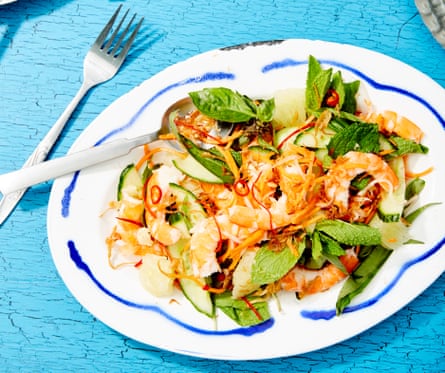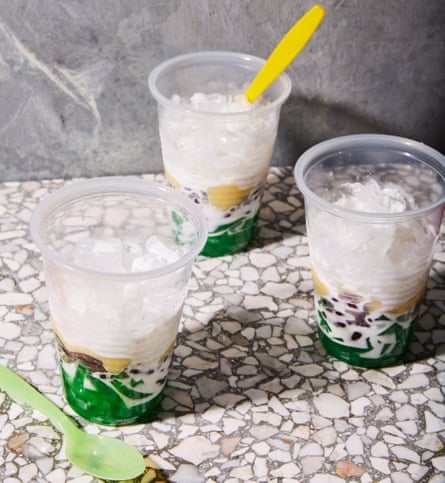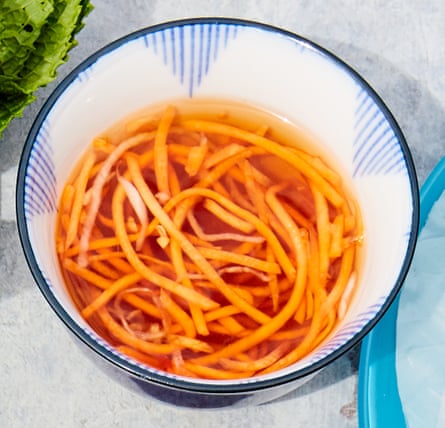When Jerry Mai migrated to Australia from Vietnam with her parents at six years old, a whole new way of eating opened up for her. She grew up eating instant noodles and “heavy meals” like fried rice for breakfast, so seeing friends eating cereal felt exciting and new. She had Fomo for their sandwiches at lunchtime even while tucking into rice paper rolls, rice and leftover curries.
“I used to love to go to my friend’s house because her parents would always make us a butter and honey sandwich and we’d have it with a cup of cordial,” the executive chef and restaurateur behind Pho Nom and Bia Hoi says.
These days, the dishes she’s grown up with are central to her cooking, at work and at home.
A typical Vietnamese spread
Head to Vietnam for a holiday and she says you’ll find locals frequenting beer halls (she has a whole chapter on beer hall eating in her book, Vietnam: Morning to Midnight) or sitting down to tables laden with dishes.
“A typical Vietnamese meal at lunch or dinner consists of several components,” she says. Meat, seafood, rice, noodles, and vegetables each get their own plate. There’s “usually a brothy soup with bitter melon or hairy leaf and a protein, like minced prawn or pork; stir-fried morning glory or mustard greens; thit kho [braised meat] or pork ribs; and a savoury seafood dish like crispy fried fish, or stir-fried calamari and pineapple”.
You’ll also find fresh cucumbers and pickled eggplants, carrots or daikon, staples alongside herbs like coriander, mint and shiso [perilla] which help to “cleanse the palate”.

In the summer, seafood features a little more prominently – usually steamed – alongside a lot of fresh salads.
“A lot of Vietnamese people run to coastal towns in the summer and get into the beach, so meals are heavily influenced by seafood, and will include salads, seafood soup, and always some steamed seafood,” she says.
What to buy
“Always have a really high-grade fish sauce,” she says. “Just like olive oil is first or second pressed, you would want a first-pressed fish sauce.” You can get one at an Asian grocer or at Coles and Woolies.
Soy sauce is essential, too: “I always have [a] Maggi sauce and a light sauce, plus an oyster sauce by Megachef or Lee Kum Kee. And caster sugar – the Vietnamese cook with a lot of caster sugar and not cane or palm sugar.”
For the pantry, she recommends instant noodles (“the kids and I eat it for breakfast”, she says), vermicelli noodles and rice paper. She says that there’s a new type of instant rice paper that’s new to the Australian market that does not need to be soaked in water, like this one, but adds that “[Vietnamese takeaway chain] Roll’d has a really good rice paper – thin, nice and silky”.
How to eat
“It’s a really well-balanced way of eating, there’s a bit of everything,” she says. “Throughout the day there’s so much snacking, too – usually green sour fruits or what we call che – so a sweet dessert, like rice balls filled with mung bean, or a taro pudding.”

Although mornings will likely entail a quick soup or a banh mi (here in Australia, hers is filled with a sunny side egg, pickles “as usual, and heaps of paté, mayo and Maggi sauce”), lunch and dinner are big family meals. Mai says a steamed or grilled fish is a great basis for roll-as-you-go rice paper rolls.
“Coming into summer, fish and rice paper rolls are very light. We have them two or three times a week,” she says. “Eating it is really community-based, just sitting around with a glass of rose while you roll.”
Jerry Mai’s cá nướng cuốn bánh tráng (grilled fish in rice paper)

“Grilled fish is very common in Vietnam, and it’s often served wrapped in fresh herbs with cucumber and pineapple to give different flavours and textures. I’ve used cod in this recipe, but you can substitute any other firm white fish, or even just use fish fillets if you don’t want to deal with the head and the bones.”
Prepare the pickled carrot and daikon (recipe below) at least two days ahead.
Prepare the spring onion oil and nuoc mam dipping sauce then set aside until ready to use.
Serves 2
1 × 400-600g (14 oz–1 lb 5 oz) whole firm white fish, such as Murray cod, seabass, snapper or flounder, gutted and cleaned
100g (3½ oz) vermicelli bun (bowl of rice noodles)
Sea salt
Vegetable oil, for rubbing
2 tbsp fried shallots
30g (1 oz) roasted peanuts
50ml (1 ¾ fl oz) spring onion oil (see recipe below)
80ml (1¹⁄3 cup) nuoc mam dipping sauce (see recipe below)
50g (1 ¾ oz) pickled carrot and daikon (see recipe below)
12 medium round rice paper sheets
For the salad plate
1 bunch Vietnamese mint
1 bunch mint
1 bunch shiso (perilla)
½ pineapple, peeled, cored and thinly sliced
2 Lebanese (short) cucumbers, cut into batons
Using a sharp knife, butterfly the fish by laying it flat on a chopping board and carefully slicing from the tail to the bottom fin along the inside of the belly up to the spine.
Open up the fish and, using a pair of kitchen scissors, cut away the spine from the tail to the neck of the fish, leaving the head and tail intact. Remove any remaining bones, then use a cleaver to slice most of the way through the head. Flatten out the fish and trim the wings and fins. Flip the fish over and repeat the process. If you’re not confident in your knives, ask the fishmonger to do this for you.
Prepare a charcoal grill or preheat a barbecue grill to high. Alternatively, preheat the oven to 180°C (350°F).
Cook the noodles according to the packet instructions, then drain and run under cold water until cool. Drain again and set aside.
Arrange the salad ingredients on a large serving platter.
When the charcoal grill is ready (the embers should be glowing red with a small flame on the charcoal), season both sides of the fish with sea salt and rub with vegetable oil. Place the fish on the grill, skin side down, and cook for five to seven minutes until the skin is crispy, then flip and cook for a further five to seven minutes until the fish is cooked through.
Transfer the fish to a plate, skin side up, sprinkle with the fried shallots and roasted peanuts and drizzle with the spring onion oil. Combine the nuoc mam and pickles in a bowl, then divide between two dipping bowls.
Arrange a large bowl of water, the noodles, dipping bowls, rice paper sheets, salad plate and fish in the centre of the table. To eat, grab a rice paper sheet and moisten with a little water. Lay the rice paper on a plate and fill with a few herbs, slices of pineapple, cucumber and a little of the fish. Roll into a tight roll and dip into the nuoc mam and pickles. Enjoy!
Đồ chua (pickled carrot and daikon)

Makes 1.3kg (2 lb)
1kg (2 lb 3 oz) carrots, cut into matchsticks
300 g (10½ oz) daikon (white radish), cut into matchsticks
For the pickle liquid
150ml (5 fl oz) white vinegar
100g (3½ oz) caster (superfine) sugar
100ml (3½ fl oz) water
To make the pickle liquid, combine the vinegar and sugar in a bowl and add 100ml water. Stir until the sugar has dissolved.
Rinse the daikon and carrot under warm running water for five minutes, then drain thoroughly and pat dry with paper towel. Transfer to a large plastic container or non-reactive bowl.
Pour the pickle liquid over the vegetables and set aside in the fridge for two days. After that, the pickles will be ready to use. Pickled carrot and daikon will keep in the fridge for up to two weeks.
Mõ’ hành (spring onion oil)
Makes 125ml (½ cup)
3 spring onions (scallions), thinly sliced
1 pinch sea salt
100ml (3½ fl oz) vegetable oil
Place the spring onion and salt in a metal bowl.
Heat the oil in a small saucepan to 150°C (300°F) on a kitchen thermometer, then pour the oil over the spring onion. Stir and set aside to infuse until you are ready to use.
Spring onion oil should be used the same day it is made.
Nu’ó’c măm (nuoc mam dipping sauce)
Makes 600ml (20½ fl oz)
2 garlic cloves, finely chopped
3 bird’s eye chillies, finely chopped or sliced
150ml (5 fl oz) fish sauce
100ml (3½ fl oz) white vinegar
140g (5 oz) caster (superfine) sugar
200ml (7 fl oz) water
Combine the ingredients in a bowl and stir until the sugar has dissolved. Nuoc mam can be kept in an airtight container in the fridge for up to two weeks.